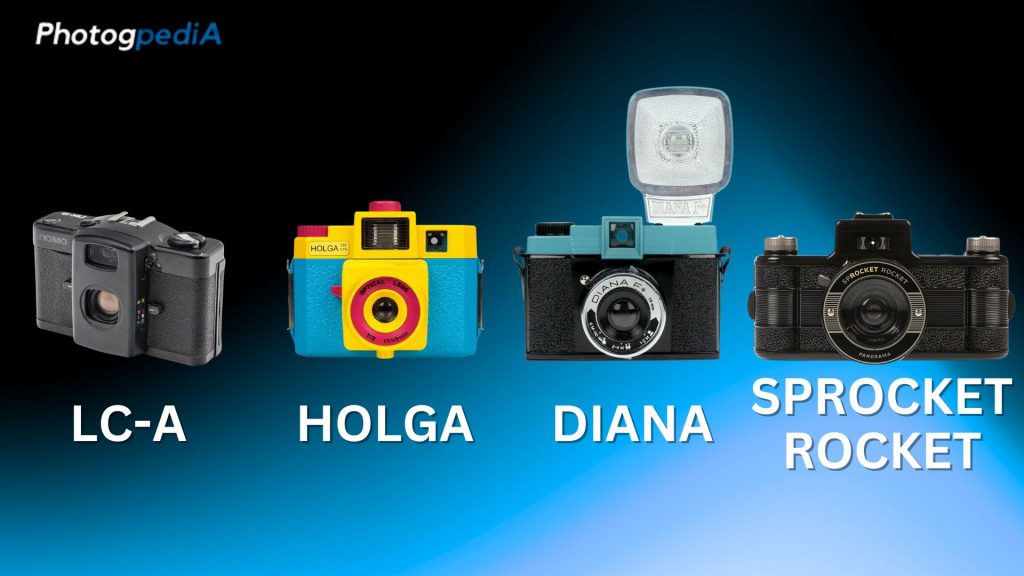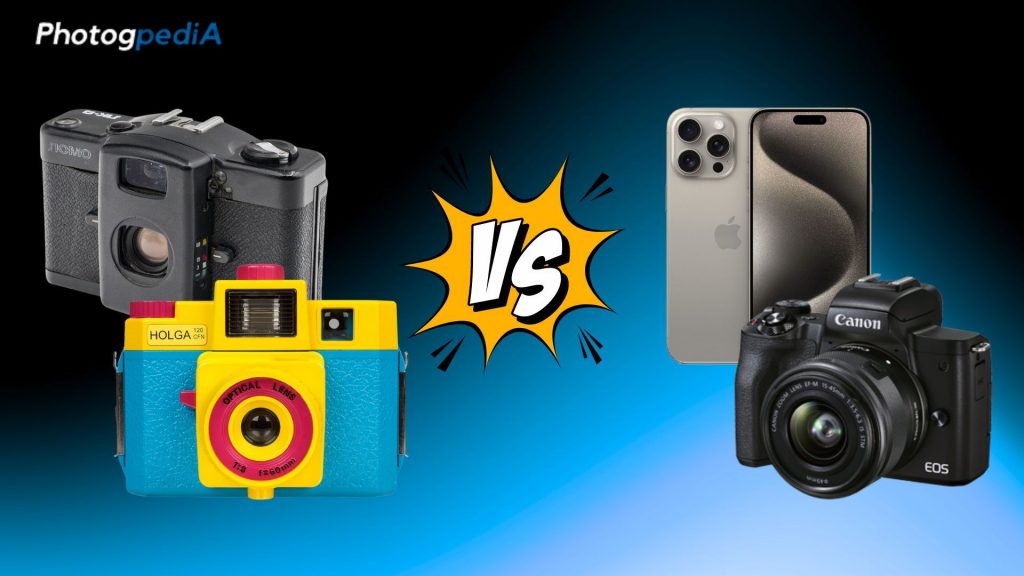As a photography geek, I’ve always been fascinated by the distinct styles and approaches that Lomography and digital photography offer. Each medium possesses its own unique charm, and choosing between them can feel like picking between two of my favorite things. This article delves into the captivating world of Lomography vs digital photography. Explore their histories, technical characteristics, and ideal uses. By the end of this journey, you’ll be well-equipped to know the difference between these. Also be equipped to decide which photographic approach best complements your creative vision and artistic goals.
Table of Contents
Introduction
What is Lomography?
Lomography, often referred to as “Lomo,” is a style of analog photography that emphasizes spontaneous, quirky, and unconventional images. It originated from the Lomo LC-A camera, produced by the Leningrad Optical Mechanical Association (LOMO) in Russia during the Soviet era.
Lomography piqued my interest because of the imperfections it boasts. They just add a layer of surprise and artistry. Moreover, they transform everyday moments into fun adventures on film.
What is Digital Photography?
Digital photography, on the other hand, feels like a whole new world of creative possibilities. Unlike Lomography’s embrace of surprise, digital photography offers a level of precision that I find incredibly empowering.
With digital cameras, light is captured by electronic sensors instead of film, and the resulting data is then processed into an image file. This digital workflow has revolutionized photography for me. Gone are the days of waiting for film to be developed, only to discover blurry or underexposed photos. With digital photography, I can see my image on the camera’s screen right after I take it. Especially on mirrorless cameras, I can instantly adjust settings and retake the shot if needed.
History of Lomography VS Digital Photography
Origin and Development of Lomography
In the early 1990s, Vienna, Austria, a group of students exploring the city found a unique camera – the Lomo LC-A, a Soviet-era creation.
Intrigued by its compact size and distinct features, they started using the camera. The results were unlike anything they’d seen before. The Lomo LC-A produced vibrant colors, soft focus around the edges (vignetting), and unpredictable effects. This differed significantly from the typical, perfect photographs of the time.
These unexpected results with the Lomo LC-A sparked a movement. In 1992, the students formed the Lomographic Society International. This marked the birth of Lomography, a global movement that celebrated imperfections and encouraged experimentation in photography.
From its student discovery origins, Lomography has grown into a worldwide phenomenon. Today, it continues to inspire photographers of all skill levels to embrace the unexpected and enjoy the unique qualities of analog photography
Evolution of Digital Photography
The story of digital photography begins in the late 20th century. It’s marked by two key advancements. The first was the development of digital imaging sensors. This replaced traditional film in capturing light information. These sensors convert light into electronic signals that can be processed and stored digitally.
Secondly, the invention of the first digital camera marked a turning point. While early models were bulky and produced low-resolution images, they laid the groundwork for the rapid advancements that followed.
This rapid progress fueled the proliferation of digital imaging devices in various forms. Compact digital cameras became increasingly popular for everyday use, offering portability and immediate image preview. High-end digital single-lens reflex (DSLR) cameras emerged, catering to professional photographers with their interchangeable lenses and superior image quality. Mobile phones also integrated digital cameras, making image capture even more accessible and ubiquitous in our daily lives.
Equipment and Gear
Cameras used in Lomography

Lomography enthusiasts often use vintage film cameras like the Lomo LC-A, Holga, Diana, and Sprocket Rocket, known for their distinct aesthetic and unpredictable results.
Lomo LC-A
The granddaddy of Lomography, the LC-A is a compact 35mm camera known for its wide-angle lens, soft focus, and light leaks that add a dreamy quality to photos.
Holga
Secondly, this quirky plastic camera boasts a medium format film size and a simple design that often produces vignetting, light leaks, and soft focus. These “imperfections” contribute to the Holga’s signature lo-fi charm.
Diana
Another plastic-bodied medium format camera, the Diana is known for its creative features like a pinhole lens option and interchangeable backs that allow for multiple exposures on a single frame.
Sprocket Rocket
Lastly, this innovative camera captures sprocket holes alongside your image, adding a unique and industrial aesthetic to your photographs.
Cameras used in Digital Photography
Digital photographers have access to a wide range of cameras, from compact point-and-shoots to high-end DSLRs and mirrorless cameras, offering superior image quality and advanced features.
Compact Point-and-Shoots
These small, user-friendly cameras are ideal for everyday photography. For instance, they offer automatic settings and basic features, making them perfect for capturing quick moments on the go.
High-End DSLRs (Digital Single-Lens Reflex)
Meanwhile these robust cameras feature interchangeable lenses, allowing photographers to customize their setup for specific situations. DSLRs offer superior image quality, fast performance, and extensive manual controls for creative expression.
Mirrorless Cameras
Combining compact size with powerful features, mirrorless cameras offer a compelling alternative to DSLRs. They utilize an electronic viewfinder instead of a mirror, resulting in a lighter and more portable body. Many mirrorless cameras boast impressive image quality and advanced features rivaling those of DSLRs.
Smartphones
Finally, mobile phone cameras have undergone tremendous advancements, offering high-resolution sensors, powerful processing capabilities, and a variety of shooting modes. Their convenience and portability make them a popular choice for everyday photography and social media sharing.
Creative Freedom
Experimental Nature of Lomography
One of the things I love most about Lomography is its experimental nature. In fact, it throws wide the doors to creativity, urging you to embrace imperfections and unexpected results. Conversely, digital photography offers a high degree of precision and control. Unlike digital photography, where you can see exactly what you’re getting on the screen, Lomography injects a delightful element of surprise.
You never quite know what you’ll get with a vintage film camera – a light leak might add a dreamy glow, or a vignette could create a dramatic frame around your subject. It’s all part of the adventure, This unpredictable nature encourages me to be more spontaneous in my approach. For instance, I find myself framing shots differently, playing with different film types, and even double-exposing frames to create surreal effects. It’s a constant exploration, a journey where the destination is just as exciting as the path itself.
Precision and Control in Digital Photography
On the other hand, digital photography offers a completely different experience. Here, I have the power of precision and control at my fingertips. The ability to see my image on the screen after every shot allows me to fine-tune exposure, adjust focus, and experiment with different settings in real-time. This level of control is empowering, especially when I’m trying to achieve a specific look or capture a fleeting moment perfectly.
Additionally, digital photography opens up a whole new world of post-processing possibilities. Software like Adobe Photoshop lets me edit my images to my heart’s content, adjusting colors, sharpening details, and even removing unwanted elements. It’s like having a virtual darkroom at my disposal, allowing me to refine my work and bring my creative vision to life with incredible accuracy and detail.
So, in conclusion, whether I’m embracing the unexpected with Lomography or wielding the power of precision in digital photography, both approaches offer unique pathways to explore my creativity and capture the world around me in a way that resonates with my artistic goals.
Popularity and Trends
There’s a distinct difference between Lomography vs digital photography. Digital photography became the undisputed champion in current times. Undoubtedly, its unparalleled convenience, versatility, and accessibility cemented its dominance in capturing and sharing images. With a digital camera, you can take hundreds (or even thousands) of photos on a single memory card. After this, review them instantly on the screen, and share them with friends and family across the globe in seconds. This ease of use makes digital photography perfect for everyone, from seasoned professionals to casual snapshot-takers.
On the other hand, Lomography has experienced a fascinating revival in recent years. Fueled by a wave of nostalgia for the analog aesthetic and a yearning for a more tactile and authentic photographic experience, Lomography offers a refreshing alternative to the digital world. There’s a certain charm in the unpredictability of film photography, the delightful surprise of waiting to see your developed photos, and the physical prints you can hold in your hand. Moreover, the Lomographic community thrives on experimentation and artistic expression, creating a unique and welcoming space for photographers of all levels to explore their creativity.
Conclusion: Capturing Your Vision – Lomography vs Digital Photography
The battle between Lomography vs digital photography isn’t a zero-sum game. Instead, both approaches offer unique strengths that can complement your artistic vision. Lomography, with its embrace of imperfections and surprises, beckons the adventurer in you. On the other hand, digital photography empowers you with control and precision, letting you meticulously craft your desired outcome.
Ultimately, the choice boils down to your creative goals. Do you crave a tactile, unpredictable experience that yields one-of-a-kind prints? Then, Lomography might be your perfect partner. Conversely, if you prioritize precision, control, and instant gratification, digital photography reigns supreme.
No matter which path you choose, remember – the most important element is capturing the world around you in a way that resonates with your artistic soul. So, go forth, experiment, and unleash your creativity!
FAQs
Is Lomography more expensive than digital photography?
While Lomography may entail higher costs for film and processing, digital photography often requires a larger initial investment in equipment.
Can digital photography replicate the aesthetic of Lomography?
Yes, digital photography can simulate the look of Lomographic images through post-processing techniques and digital filters.
Are there any environmental benefits to using Lomography over digital photography?
Lomography promotes sustainability by encouraging the reuse of film cameras and minimizing electronic waste.
Which medium offers greater creative freedom: Lomography or digital photography?
Both Lomography and digital photography offer unique opportunities for creative expression, depending on the photographer’s preferences and artistic vision.
Is Lomography still relevant in the age of digital photography?
Yes, Lomography remains relevant as a niche artistic movement and alternative to mainstream digital photography, attracting enthusiasts who appreciate its analog aesthetics and experimental ethos.
Afterword
We hope that you find this article helpful. Thank you for reading and you’re always free to leave a comment. If you find this article interesting, consider checking out one of our recently published posts. A few of them showcase advancements in technology such as AI Art Generators. On the other hand, if you’re looking towards Photography, we also offer great articles for your inspiration. We also have multiple articles that talk about the various printing mediums for wall art. May these articles give you inspiration for your next print!
Find them here:
Discover the Secret to High-quality Canvas Prints
The 9 Best Canvas Print Companies in 2023
Acrylic Prints: Add Vibrance to Any Space
The Top Food Photography Trends to Try Now
The Ultimate Guide to Continuous Lighting for Photography
Stable Diffusion Tips and Tricks
Best AI Art Generator for Android Phones 2023
We enjoy reading your comments and insights with our posts! Should you have any questions or concerns, feel free to leave them below! -Mark

